Start building furniture with less
Want to start woodworking but can’t afford a fully outfitted shop? Erik Curtis implores you to stop being elitist about biscuit joinery.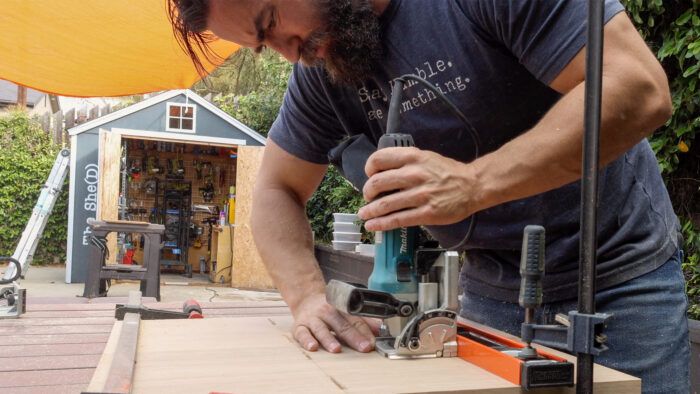
Let’s all say it together now: Woodworking is an expensive hobby. Sure, one could argue that one well-made table that costs $1,000 in materials is far less expensive long-term than buying a $500 one every few years for the next five decades, and that’s a strong argument. But I should first remind the early 20-something buried deep inside you that $1,000 ain’t chump change. Secondly, that equation overlooks the thousands of dollars in machinery and hand tools in a typical shop, let alone the shop space itself (which, given the current housing market, is hardly “free”). How is one supposed to create the necessary mortise-and-tenon joinery or those classic breadboard ends sans expensive equipment? What is a person to do with an insatiable desire to make furniture and a budget closer to Jiminy Cricket than Jeff Bezos?
One word. Biscuits.
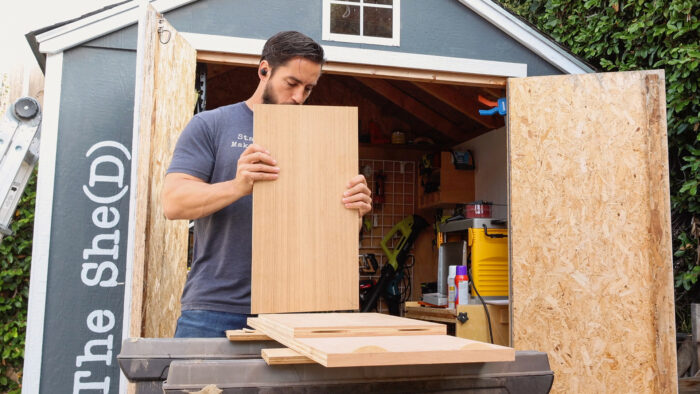
Here’s the honest truth about woodworking: It’s not complicated. It’s a series of steps cutting wood into smaller parts to glue them back into larger parts. That’s it. That’s the whole game. What method you choose to employ to meet that end is entirely up to you. Want to spend a couple grand on hand tools or router jigs to make the finest dovetails this side of the Mississippi? Go for it. But you know what joins a corner just as well? Biscuits. An industry standard for decades, the biscuit is severely underrated in the furniture world. A biscuit joiner is cheap (comparatively) and the reality is every cabinet you’ve ever purchased that wasn’t made in a studio furniture shop was made with biscuits. And they’ve held up more than OK. I put biscuits to good use recently working in my friend’s shed to build her a new bathroom vanity. With nothing more than a few basic tools, we were able to make a lovely little cabinet that complements her bathroom really nicely.
If you’re looking to start building objects, all you really need are the following: something to cut, something to join, and something to surface. You can start making cabinets tomorrow with nothing more than a circular saw, a biscuit joiner, and a sander. A little glue and a couple cheap clamps later and you’ve got yourself a custom cabinet. But what about that aforementioned dining table? You can’t make a table with just those tools, right? You’d better believe you can. Just get your wood milled S3S at the lumberyard. Then you can proceed with the same three tools to build the dining table you’ve always wanted. Don’t think biscuits will hold up to the wear and tear of a dining table, eh? Consider this: All the joinery on my workbench, which I made about 13 years ago, was done with biscuits. And it’s my daily use bench. It has lived in four different shops in that time, none of which were climate-controlled, and I have never had an issue. I’ll say it again: The biscuit is severely underrated.
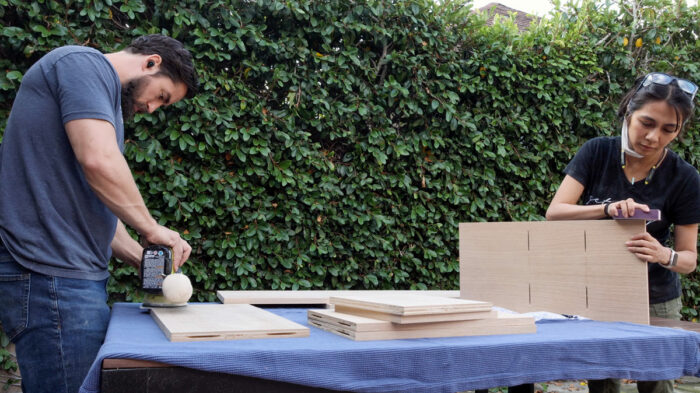
Don’t let anyone tell you that you need this or that to start woodworking. The best tool for you is the tool you can afford. You can get a biscuit joiner, a circular saw, and a random-orbit sander secondhand for less than $500 total. Then take what precious few dollars you have left over, head to the lumberyard, and purchase the least expensive domestic hardwood you can find. Beech is a great choice. Red oak is also relatively inexpensive. Both will make a table that will last for decades.
Now go and be merry, my friends. Biscuit the world together. One project at a time.
Erik Curtis
Fine Woodworking Recommended Products

Ridgid EB4424 Oscillating Spindle/Belt Sander

Stanley Powerlock 16-ft. tape measure

Festool DF 500 Q-Set Domino Joiner

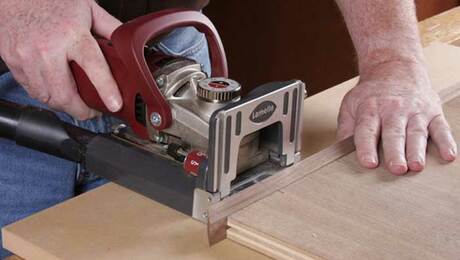
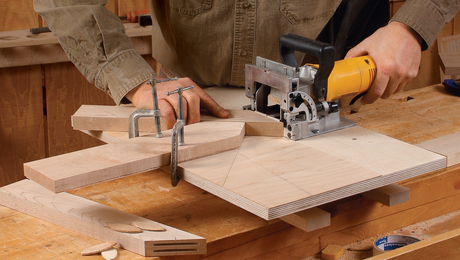
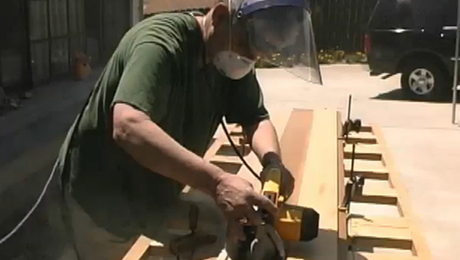





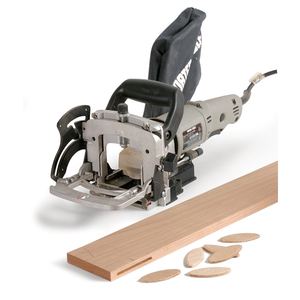
















Comments
Much of my earlier furniture was made with biscuits, employing a Mafell biscuit jointer for its precision. You're right that biscuits make strong joints - all that furniture I made is still extant and doing well. But you need a precise biscuit slot-making machine, not the cheap and floppy sort.
These days, and for the past decade, a Festool Domino has taken the place of the biscuit joiner. In fact, two of them have, as the bigger Domino is better for large things like big beds and full size doors. Dominoes are that bit more versatile than biscuits albeit very similar in how they work.
May I now recommend another time, money and learning-time saver/shortcut - high quality veneered blockboard (and sometimes MDF, although that's not as good strength-wise). This comes in the thickness you want with some very nice plank-like grain patterns from the flitch-cut (rather than rotary cut) veneers.
Here's some photos illustrating both biscuits and veneered blockboard. Once the furniture is made, its very hard to detect that it wasn't build in the traditional way, especially if the honest (visible) joints such as dovetails are the real thing.
The tall boy is cherry-faced 19mm blockboard with some solid cherry lipping, with solid cherry dovetailed drawers. The wee waste bin is solid flame birch with a cherry top rail, all biscuited together.
The 8-leg table is ash with a top having a veneered MDF central panel framed in solid ash with cherry stringing delineating them. The veneered blockboard shows flitch-cut quarter-sawn oak veneer "planks" with spectacular medullary rays. Sadly, I forgot to take its picture after the finish went on to pop the grain.
A big regret I have is waiting till I moved back into a home in 2013 to start woodworking. I did some woodworking in 2001 with a good friend and knew I wanted to do more. Even bought some tools for the garage. Then, in 2004 I moved cities and couldn’t afford a home in new city and was in a condo. Had sold the tools and told myself I couldn’t woodworking till I was back in a home. Took about a decade till I got back into a home. I could have woodworked. At the very least, I could have done carvings in basswood, carved wooden spoons, chip carvings, or characteriture carvings in basswood. Didn’t do it. In 2015 started woodworking. Just feel like a lost a decade. Encurtis is correct. You really can do woodworking with very little.
"How is one supposed to create the necessary mortise-and-tenon joinery or those classic breadboard ends sans expensive equipment? "
The answer is not biscuits (or dominos or dowels). Simply make mortice-and-tenon joints. They are free ... and stronger.
Regards from Perth
Derek
Here is the perfect proof of the elitist biscuit hate. The title of the post is "START building furniture...". For many beginners mortise and tenon joints are too daunting of a prospect. Leave them alone.
No Ben. Not biscuit hate. Simply a M&T is not just stronger, but also cheaper. The topic of the article is "Pro Level DIY" and the subtext is "Want to start woodworking but can’t afford a fully outfitted shop?". I've been building furniture for over 30 years, and did not start out with much in the way of power tools as I could not afford them. That did not stop me ... I just learned to do it the time-honoured way. Today I own a nice DeWalt biscuit joiner and a Festool Domino, but traditional joinery remains my go-to. And, no, mortice-and-tenon joinery is not "hard" to do. Like anything that is worthwhile, it requires a little persistence. If I do have an "elitist" issue, it is that too many want or expect quick and easy, and do not make the effort. Train the hand first. Regards from Perth, Derek
It's certainly the case that traditional M&T joinery requires less tool-spend than a good biscuit joiner or a Fezzy Domino machine. Well .... it does if you buy fairly basic mortise chisels, saws to make the tenons and maybe a cheap router plane to make sure that they fit together well, without a skew. On the other hand, you can very quickly spend more on such tools than the cost of that Domino machine if you go up-market.
There is another sort of spending for the novice woodworker - time. Traditional M&Ts require not just more time to make but a very long time to learn to make well. As Derek says, it requires "persistence" ... but more than a "little persistence".
Still, you get more than a potential smaller tool cost and the pleasure of tradition with hand-made traditional M&Ts. You get some skills that transfer to other aspects of woodworking that using machines probably don't induce in you.
Are traditional M&Ts stronger? Not necessarily. The strength of all versions of the joint depends on how well that joint is made. It's a lot easier to make a poor traditional M&T than it is a machine made version. Ask me how I know this. :-)
I agree with Derek's thought process.
I understand that everyone has their own woodworking philosophy and motivations. To me, the journey is just as import as the destination. I am not a professional woodworker but have been working wood for over 40 years. I get great satisfaction from the "build process" which includes improving my design, problem solving, and hand skills as opposed to my machine skills.
I guess I am a bit idealistic.
What about maker spaces as a way to start out on woodworking. For a reasonable price, you get access to all the machinery you'd ever need and classes on how to use them plus access to all the other shops (metal, fabric, glass....). Plus you meet all kinds of people that are willing to show a newbie the ropes. Beats a biscuit joiner any day.
Log in or create an account to post a comment.
Sign up Log in